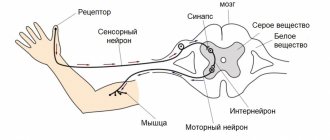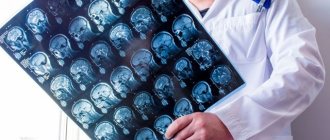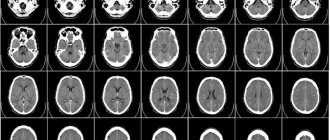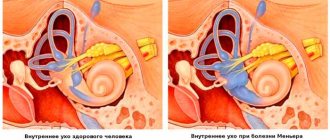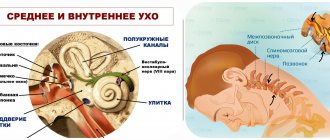What diseases does a neurologist treat?
- cardiovascular - hemorrhagic and ischemic stroke;
- infectious - damage to the central nervous system due to syphilitic and AIDS infections, herpetic encephalitis;
- degenerative - Parkinson's and Alzheimer's diseases;
- traumatic - bruises of varying severity, concussions, diffuse damage to axons in traumatic brain injuries;
- pathologies of the cerebrospinal fluid system - persistent increase in intracranial pressure, hydrocephalus;
- demyelinating - Guillain-Barré syndrome, multiple sclerosis;
- helminthiasis - opistrochiasis, echinococcosis;
- oncological - gliomas, meningiomas;
- mycotic - candidiasis, cryptococcosis of the central nervous system;
- epileptic - primary (without involvement of the brain matter in the pathological process) and symptomatic epilepsy caused by traumatic brain injury, tumors;
- congenital - cerebral palsy.
What does a pediatric neurologist do?
Child neurology is a highly specialized branch of general neurology. Young patients have certain characteristics of these diseases, so the doctor must have special knowledge. What does a pediatric neurologist treat? The most common diseases that a specialist has to deal with are:
- Cerebral palsy.
- Sleep and behavior disorders.
- Infectious diseases of the nervous system (meningitis and encephalitis).
- Enuresis.
- Congenital anomalies.
- Epilepsy.
There is also a certain specificity in the treatment of childhood neurological diseases. In particular, a pediatric neurologist actively prescribes various rehabilitation methods: osteopathy, reflexology, exercise therapy, sensory integration, etc. At the same time, the child’s parents also take an active part in the rehabilitation process.
How does an appointment with a neurologist proceed?
The initial consultation includes a survey and neurological examination of the patient. During the conversation, the doctor listens to complaints and asks additional questions. During the examination, reflexes and the presence of external signs are checked - symmetry of the shoulders and limbs, disorders of posture and motor ability. For a professional neurological examination, special instruments are used, the set of which depends on the nature of the disease. It could be:
- hammer (reflexes);
- needle, brush/cotton wool (deep and superficial pain sensitivity, respectively);
- tuning fork (susceptibility to vibration);
- compass (sensitivity at different points of the body);
- pens, pencils, keys (object sensitivity);
- dynamometer (muscle strength measurement).
Diagnostic methods
Examination using instrumental and (less often) laboratory methods is an integral part of the diagnosis of neurological diseases and their complications. The choice of a specific technique is carried out taking into account the nature of the violations. In modern diagnostics, one or more studies from the following list may be used:
- magnetic resonance imaging, or MRI. The procedure is performed with or without contrast; a contrast tomogram has more accurate results;
- computed tomography, or CT scan, of the brain;
- echoencephalography (ECHO-EG), positron emission tomography (PET/CT);
- angiography of cerebral vessels;
- X-ray, ultrasound of the spinal column;
- myelography;
- ultrasound with Doppler (Doppler scanning);
- electroneuromyography (EEG);
- gamma encephalography (EEG).
For radiculitis and intervertebral hernias, a lumbar puncture may be prescribed. A number of diseases require blood and urine tests.
How does an appointment with a neurologist go: what does the patient need to know?
The most complex system in our body.
The main causes of neurological disorders are stress, sedentary lifestyle and dietary errors. Thus, today the absolute majority of the young working population is susceptible to neurological diseases, especially in large cities. Periodic headaches, dizziness, discomfort in the back, sleep problems, cramps in the limbs - perhaps these symptoms are familiar to everyone today. We are used to not paying attention to them, chalking them up to bad weather or fatigue. However, such seemingly harmless sensations are most often symptoms of a neurological disease. The nervous system, central and peripheral, are the main systems of the human body that control and perform all our vital functions. There is an opinion that the nervous system is the most important and most complex system in our body.
Fortunately, as a rule, most neurological diseases respond well to comprehensive treatment, especially in the early stages. At the BELSONO medical center in Gomel, highly qualified neurologists with many years of practice receive treatment. We will help you accurately determine the diagnosis and develop a treatment regimen that is necessary specifically in your case.
What does a neurologist treat: what diseases?
The basis of diseases of the nervous system is a disruption in the functioning of neurons, nerve cells, a weakening of the connection between them, as well as inflammatory processes in the brain and spinal cord.
The most common in practice:
· Lumbosacral and cervical radiculopathies
· Vertebrogenic thoracalgia
Vertebro-basilar insufficiency
Inflammatory processes of peripheral nerves - neuritis, neuralgia
Migraine and tension headaches
· Astheno-neurotic disorders
· Convulsive syndromes.
How does an appointment with a neurologist go: what does the patient need to know?
During an initial visit to a neurologist, the specialist will need to ask the person in detail about the complaints, that is, collect a history of the disease.
The specialist examines the appearance (appearance) of the patient for the presence of asymmetry of the face and various parts of the body.
To study the work of the oculomotor nerves, you will need to follow the movements of the hammer without turning your head.
The doctor can check your reflexes using your facial expressions. The neurologist will ask you to wrinkle your forehead, stick out your tongue, or say “Ah.”
You can check the sensitivity of your face using a needle. Don’t be scared; you will need to concentrate as much as possible and answer the neurologist’s questions about whether you experience the same sensations when receiving injections in symmetrical zones.
To determine the condition of the muscles, their tone and reflexes, the doctor will be asked to shake his hand and resist when trying to bend the elbow. Evaluation occurs by assigning points from 1 to 5.
Deep reflexes of the arms and legs are tested by striking the tendons with a hammer.
Superficial reflexes are tested by irritating the skin of the abdominal wall with a needle.
A deep examination of muscles and joints is carried out when the patient's eyes are closed, and the doctor moves his finger in different directions and asks him to name exactly in which direction he is doing it.
Palpation of paravertebral points helps determine the condition of the spinal nerves and paravertebral pain points.
Coordination of movements is tested by the Romberg pose. The patient stands with his feet together, arms extended forward, eyes closed. The neurologist will ask you to slowly move your index finger to your nose (with each hand). In this study, a person should ideally not stagger to the sides.
You may need to answer specific questions about counting or dates to assess memory.
Additional examination of patients.
Not in all cases it is possible to make a diagnosis based on clinical data. There is a need for additional studies that will provide detailed information about the patient's condition. Unfortunately, not all of the methods listed below are yet available in our medical centers. As BELSONO develops, it plans to launch MRI, angiography and radiology techniques in a phased manner.
*CT scan. Identifies areas of hemorrhage, malformations of arteries or veins. Allows you to see tissue changes, swelling, softening during a heart attack (stroke) or injury.
*Magnetic resonance imaging. A more modern diagnostic method provides more detailed and accurate data due to the greater resolution of the device and does not have such a detrimental effect on the patient. But it should be noted that in some cases CT and MRI are not mutually exclusive methods and they have their own diagnostic features.
*Angiography. Contrast X-ray examination, which reveals pathologies and changes in blood vessels, including in the brain.
*Ultrasound of BCA. Using this study, a detailed image of the large vessels of the neck is obtained and the characteristics of blood flow are determined.
*Lumbar puncture or cerebrospinal fluid analysis.
*X-ray. Contrast is used to detect intervertebral disc herniations, proliferation of vertebral bodies, and tumor processes. The study gives a clear picture of the state of the subarachnoid space of the entire spinal cord.
*Electroencephalography.
The main test prescribed for patients with suspected epilepsy.
And there are quite a lot of methods and studies that help in diagnosing diseases: biopsy of muscles, nerve tissue, genetic studies, blood tests.
Successful treatment requires finding out the cause of the pain and making the correct diagnosis.
And for this you need to contact a neurologist. You shouldn’t let the disease get started; it’s much easier to defeat it in its infancy! You can make an appointment with a neurologist in Gomel by calling our medical centers, as well as through the online appointment form on the website.
Principles of treatment
What does a neurologist do when there is already a diagnosis? Begins to treat the disease using different methods.
Medicines
To relieve acute pain and inflammation, medications are prescribed, and maintenance therapy is provided if necessary. Problems with blood vessels, concussions, epilepsy, and conditions after surgery almost always require medication.
Manual therapy
Manual therapy is a treatment with hands (from the Latin manus - hand), which helps eliminate functional blocks and muscle spasticity, normalize microcirculation and range of motion. Widely used for diseases of the joints and spine, neuroses.
Massotherapy
One of the most effective methods of treating neurological diseases, along with therapeutic exercises and physiotherapy. Using special techniques, the specialist gently influences the patient’s body to stimulate the body’s natural recovery processes.
Physiotherapy
Through physical techniques, it is possible to accelerate tissue regeneration processes, improve nerve conduction, thereby reducing the intensity of pain and inflammation.
Reflexology
The essence of the method is the impact on bioactive points to restore the disturbed balance. It is based on the idea of the body as an integral system, when one of its elements fails, others suffer.
Traction traction
Used to stretch limbs and muscles in case of bone fractures and diseases of the spine.
Kinesitherapy
“Movement treatment” is how this term is translated from scientific language. This is a type of physical therapy that combines medical, physiological, and biochemical aspects.
Osteopathy
This is a method similar in effectiveness to massage and manual techniques. But, unlike them, it affects the very cause of the disease, helping to restore the well-coordinated functioning of the body.
Therapeutic blockades
For severe pain that cannot be relieved with conventional medications, the sore spot is injected. Injections are made directly into the painful area, hitting the nerve endings. The procedure relieves a person from pain in a matter of minutes for a period of half an hour to several days.
